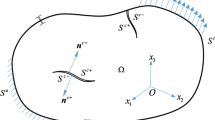Abstract
In this paper a dual boundary element formulation is developed and applied to the evaluation of stress intensity factors in, and propagation of, axisymmetric cracks. The displacement and stress boundary integral equations are reviewed and the asymptotic behaviour of their singular and hypersingular kernels is discussed. The modified crack closure integral method is employed to evaluate the stress intensity factors. The combination of the dual formulation with this method requires the adoption of an interpolating function for stresses after the crack tip. Different functions are tested under a conservative criterion for the evaluation of the stress intensity factors. A crack propagation procedure is implemented using the maximum principal stress direction rule. The robustness of the technique is assessed through several examples where results are compared either to analytical ones or to BEM and FEM formulations.
Similar content being viewed by others
References
Bakr, A.A. and Fenner, R.T. (1985). Axisymmetric fracture mechanics analysis by the boundary integral equation method. International Journal of Pressure Vessels and Piping 18, 55–75.
Becker, A.A. (1986). The Boundary Integral Equation Method in Axisymmetric Stress Analysis Problems, Springer-Verlag, Berlin.
Benthem, J.P. and Koiter, W.T. (1973). Asymptotic Approximations to Crack Problems in Mechanics of Fracture (Edited by G.C. Sih), Noordhoff, Leiden, 131–178.
Brebbia, C.A., Telles, J.C.F. and Wrobel, L.C. (1984). Boundary Element Techniques, Springer-Verlag, Berlin.
Bush, M.B. (1999). Simulation of contact-induced fracture. Engineering Analysis with Boundary Elements 23, 59–66.
Chen, S.Y. and Farris, T.N. (1994). Boundary element crack closure calculation of axisymmetric stress intensity factors. Computers & Structures 50, 491–497.
Cruse, T., Snow, D.W. and Wilson, R.B. (1977). Numerical solutions in axisymmetric elasticity. Computers & Structures 7, 445–451.
Davis, P.J. and Rabinowitz, P. (1984). Methods of Numerical Integration, Academic Press, New York.
Demir, I., Hirth, J.P. and Zbib, H.M. (1992). The extended stress field around a cylindrical crack using the theory of dislocation pile-ups. International Journal of Engineering Science 30, 829–845.
Gray, L.J., Martha, L.F. and Ingraffea, A.R. (1990). Hypersingular integrals in boundary element fracture mechanics. International Journal for Numerical Methods in Engineering 29, 1135–1158.
Guiggiani, M. (1995). Hypersingular boundary integral equations have an additional free term. Computational Mechanics 16, 245–248.
Hellen, T.K. (1976). Finite Element Energy Methods in Fracture Mechanics, Ph.D. Thesis, University of London.
Irwin, G.R. (1957). Analysis of stresses and strains near the end of a crack traversing a plate. Journal of Applied Mechanics 24, 361–364.
Kermanidis, T. (1975). A numerical solution for axially symmetrical elasticity problems. International Journal of Solids and Structures 11, 493–500.
Krishnasamy, G., Schmerr, L.W., Rudolphi, T.J. and Rizzo, F.J. (1990). Hypersingular boundary integral equations: some applications in acoustic and elastic wave scattering. ASME Journal of Applied Mechanics 57, 404–414.
de Lacerda, L.A. and Wrobel, L.C. (2001). Hypersingular boundary integral equation for axisymmetric elasticity. International Journal for Numerical Methods in Engineering 52, 1337–1354.
Leung, A.Y.T. and Su, R.K.L. (1998). Two-level finite element study of axisymmetric cracks. International Journal of Fracture 89, 193–203.
Lutz, E.D., Gray, L.J. and Ingraffea, A.R. (1990). Indirect evaluation of surface stress in the boundary element method, Proceedings of IABEM'90, Rome.
Mayr, M. (1976). The numerical solution of axisymmetric elasticity problems using an integral equation approach. Mechanics Research Communication 3, 393-398.
Miyazaki, N., Ikeda, T. and Munakata, T. (1989). Analysis of stress intensity factor using the energy method combined with the boundary element method. Computers & Structures 33, 867–871.
Portela, A., Aliabadi, M.H. and Rooke, D.P. (1991). The dual boundary element method: effective implementation for crack problems. International Journal for Numerical Methods in Engineering 33, 1269–1287.
Rybicki, E.F. and Kanninen, M.F. (1977). A finite element calculation of stress intensity factors by a modified crack closure integral. Engineering Fracture Mechanics 9, 931–938.
Selvadurai, A.P.S. (1998). The modelling of axisymmetric basal crack evolution in a borehole indentation problem. Engineering Analysis with Boundary Elements 21, 377–383.
Sneddon, I.N. (1946). The distribution of stress in the neighborhood of a crack in an elastic solid. Proceedings of the Royal Society of London A187, 229–260.
Telles, J.C.F. (1987). A self-adaptive co-ordinate transformation for efficient numerical evaluation of general boundary element integrals. International Journal for Numerical Methods in Engineering 24, 959–973.
Author information
Authors and Affiliations
Rights and permissions
About this article
Cite this article
de Lacerda, L., Wrobel, L. Dual boundary element method for axisymmetric crack analysis. International Journal of Fracture 113, 267–284 (2002). https://doi.org/10.1023/A:1014289127860
Issue Date:
DOI: https://doi.org/10.1023/A:1014289127860




